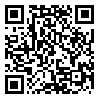Volume 14, Issue 4 (Occupational Medicine Quarterly Journal 2023)
tkj 2023, 14(4): 14-24 |
Back to browse issues page
Ethics code: IR.MUK.REC.1397/256
Download citation:
BibTeX | RIS | EndNote | Medlars | ProCite | Reference Manager | RefWorks
Send citation to:



BibTeX | RIS | EndNote | Medlars | ProCite | Reference Manager | RefWorks
Send citation to:
jannaty R, abedi K, jannaty L. Evaluation of effective parameters on the causes of occupational accidents in the construction industry using the combined method of Fuzzy logic-AHP and Pareto theory (Case study: Kurdistan province). tkj 2023; 14 (4) :14-24
URL: http://tkj.ssu.ac.ir/article-1-1222-en.html
URL: http://tkj.ssu.ac.ir/article-1-1222-en.html
, rasouljannaty@gmail.com
Abstract: (1336 Views)
Introduction: Statistics show that occupational accidents in the construction industry are relatively high. Also, a significant percentage of these accidents in this industry leads to death. Therefore, in this study, the parameters affecting the causes of occupational accidents in the construction industry were evaluated using the combined method of Fuzzy logic-AHP and Pareto's theory in Kurdistan province, and management and engineering mitigation measures were determined.
Methods and Materials: In this study, the effective parameters in the occurrence of accidents in the construction industry were identified and a questionnaire based on fuzzy hierarchical analysis was designed and distributed, which was completed by 83 occupational health and safety specialists in the Kurdistan province of Iran. The data analysis was done based on Fuzzy logic-AHP and Pareto theory.
Results: In the evaluation of this study, out of the set of eight factors, unsafe conditions were found to be the most influential factor. Also, among the sub-factors of this index, the two parameters of lack of scaffolding and safety equipment for working at height and lack of protective fences in existing cliffs were the most important.
Conclusion: Based on these results, it is suggested that to reduce the occurrence of accidents in this industry, control measures to create safe working conditions at height should be prioritized. Also, paying attention to the parameters determined by the Pareto theory in each factor can easily reduce more than 80% of the causes of occupational accidents in this industry.
Methods and Materials: In this study, the effective parameters in the occurrence of accidents in the construction industry were identified and a questionnaire based on fuzzy hierarchical analysis was designed and distributed, which was completed by 83 occupational health and safety specialists in the Kurdistan province of Iran. The data analysis was done based on Fuzzy logic-AHP and Pareto theory.
Results: In the evaluation of this study, out of the set of eight factors, unsafe conditions were found to be the most influential factor. Also, among the sub-factors of this index, the two parameters of lack of scaffolding and safety equipment for working at height and lack of protective fences in existing cliffs were the most important.
Conclusion: Based on these results, it is suggested that to reduce the occurrence of accidents in this industry, control measures to create safe working conditions at height should be prioritized. Also, paying attention to the parameters determined by the Pareto theory in each factor can easily reduce more than 80% of the causes of occupational accidents in this industry.
Keywords: Safety, Occupational Accidents, Construction, Fall from a height, Fuzzy logic, Pareto's theory
Type of Study: Research |
Subject:
Safety and occupational accidents
Received: 2022/12/18 | Accepted: 2023/03/1 | Published: 2023/03/1
Received: 2022/12/18 | Accepted: 2023/03/1 | Published: 2023/03/1
Send email to the article author
| Rights and permissions | |
 |
This work is licensed under a Creative Commons Attribution-NonCommercial 4.0 International License. |







